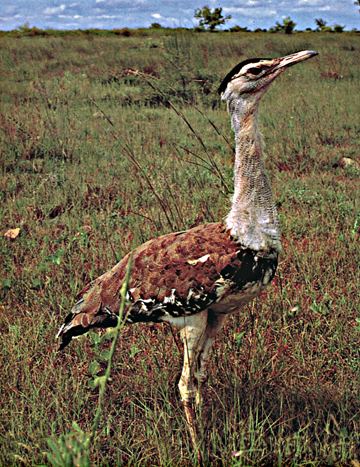Coordinates Google Maps | Area 1,222 km² | |
 | ||
Xylo mahindra drive by shirishkumar patil at great indian bustard sanctuary nannaj
Great Indian Bustard Sanctuary (established in 1979, also known as the Jawaharlal Nehru Bustard Sanctuary of Maharashtra) is a wildlife sanctuary for the great Indian bustard (Ardeotis nigriceps) at Solapur, Maharashtra, India. The land is drought-prone and semi-arid.
Contents
- Xylo mahindra drive by shirishkumar patil at great indian bustard sanctuary nannaj
- Data on the sanctuary
- Drought Prone Areas Programme DPAP Plots
- Habitat types in Nannaj plots
- Need for habitat management
- Removal of trees by the forest department
- References
Maharashtra is one of the six states of India where great Indian bustards (Ardeotis nigriceps) are still seen. The great Indian bustard at Nannaj and Karmala was first identified By Mr B.S.Kulkarni in 1972 and with his constant efforts to save the bird had resulted in Dr. Salim Ali visiting Nannaj and starting a research project. Mr Kulkarni wrote extensively in local newspapers and made people aware of its existence and he is still active in trying to protect the bird and its habitat at Nannaj, near Solapur. In former days the bustard was a common bird in the dry districts of Maharashtra.
Data on the sanctuary
Drought Prone Areas Programme (DPAP) Plots
In 1975 the Drought Prone Areas Programme (DPAP), financed by the World Bank, was initiated in Solapur district . Establishment of pastures and woodlots by the forest department under DPAP resulted in regeneration of wildlife, benefited by the protection of their habitat (Rahamani, A. R. Final Report 1989, BNHS).
Habitat types in Nannaj plots
Habitat of Nannaj can be broadly divided into five main types (Manakadan, R. and Rahmani, A. R. 1986 Annual Report No. 3, BNHS, Rahmani, A. R. Final Report 1989 BNHS).
- Grassland plots - Mardi 100 and Mardi 50 plots are pure grassland, with few young Acacia nilotica trees and Cassia auriculata bushes. Prominent grasses are Aristida funiculate, Aristida stocksii, Chrysopogon fulvus, Heteropogon contortus, Lodhopogon tridentatus, Melanocenchris jacquemontii.
- Woodlot (Nannaj plots)- In some of the areas the following trees were planted by the forest department: Acacia nilotica, Albizia lebbeck, Gliricidia sepium, Dalbergia sissoo, Azadirachta indica, Hardwickia binata, Sapindus emarginatus and Tamarindus indica. These plots have become extremely thick in the past years, and the grassland has been converted to woodland.
- Grazing land
- Stony grazing land
- Crop fields
Need for habitat management
Some of the areas like Nannaj 10 ha (close to mardi, 100 hectare) and Karamba (also close to Mardi, 50 hectare) were planted with exotic plant species like Gliricidia sepium, Azadirachta indica. Because of the dense growth of weeds like Hyptis suaveolens and Lantana camara, these areas became dense woodlands.
Pictures taken from Google Earth effectively shows how dramatically habitat has changed from scrubland and grassland to dense woodland.
The idea of no tree plantain proposed by some and other are not proper there has to be some trees which are not tall and there has to be the proper grassland so that the bird can hide and fly. If the camouflage is not there the bird has chance to fall prey to poachers.
What are these recommendations?
These recommendations were included in management plan of the sanctuary but nothing much was done for the management of grasslands in Great Indian Bustard Sanctuary, Nannaj, Solapur.
Removal of trees by the forest department
With reference to above recommendations in the management plan, Forest Department (Wildlife Division) Pune submitted a proposal to PCCF Maharashtra in 2006 for the uprooting and cutting of trees like Gliricidia and Lantana in Nannaj and Karamba areas. With allotments of funds, actual work started in March 2008 under the guidance of Conservator of Forest (Wildlife Division) Pune Dr. Y L P Rao.
Total 25 hectares of land was cleared out of trees, of which 10 hectares at Nannaj 10 ha area (near Kale Talav) and 15 hectares at Karamba (near Mardi 50 hectare). Trees like Gliricidia, Neem and Lantana were cut and then uprooted so as to prevent their regrowth. A total of 15,240 trees were uprooted from 25 hectares of land.
On 15 August 2009, an observer saw one male great Indian bustard in the newly opened Nannaj 10 (Near Kale Talav) plot. The bustard was seen foraging and the observer continued to observe the bird for about 45 minutes in 10 ha (from 7:15 to 8:00 am). Then the bustard crossed the TCM by walking and entered the Mardi 100 hectare area.
The following species of birds have been observed in newly opened areas:
A majority of the above-mentioned species are grassland birds. These observations suggest the acceptance of newly opened habitat by great Indian bustard and also by various other bird species.
The Forest Department has proposed to uproot about more 5,244 trees in Mardi, Akolekati and Karamba plots. This will help in restoration of proper habitat for bustards.
